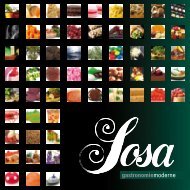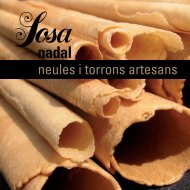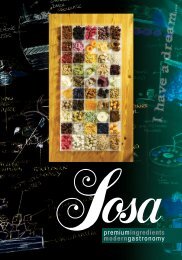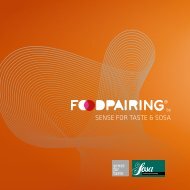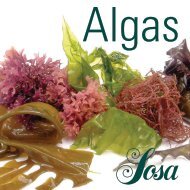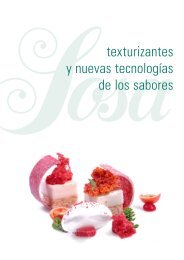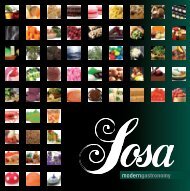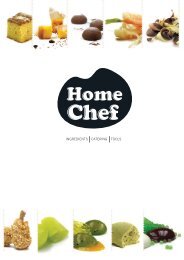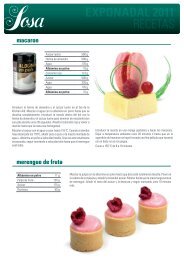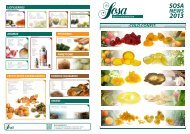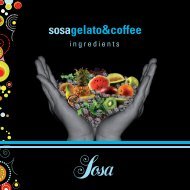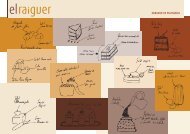The technology of flavours - Sosa
The technology of flavours - Sosa
The technology of flavours - Sosa
Create successful ePaper yourself
Turn your PDF publications into a flip-book with our unique Google optimized e-Paper software.
<strong>The</strong> <strong>technology</strong> <strong>of</strong> <strong>flavours</strong><br />
Flavour and taste, together with touch and smell, materially<br />
approach us to the pleasure <strong>of</strong> senses. <strong>The</strong> sense <strong>of</strong> touch can<br />
inform us about material objects, based on physical contact,<br />
on sensations related to pressure and temperature, but taste<br />
and smell are chemical. With these senses we really detect<br />
molecules.<br />
We count with ten receptors in the tongue, the palate, and<br />
the pharynx to perceive <strong>flavours</strong>. We have about ten thousand<br />
receptors in total located in the so called taste buds, although<br />
there are people who have a larger number (until 30000), and<br />
that is why they have the ability to appreciate <strong>flavours</strong> better.<br />
<strong>The</strong> receptor cells are connected to nerve fibres, so the impulses<br />
generated get to the brain through one <strong>of</strong> the four cranial nerves,<br />
and there, signals are transformed into what we call flavour. <strong>The</strong><br />
number <strong>of</strong> receptors diminishes with age, that is to say, that a<br />
young person can appreciate sweet flavour in water if it contains<br />
only 1 gram <strong>of</strong> sugar per litre, whereas at the age <strong>of</strong> 70,<br />
one might need ten times more to be able to appreciate it. Young<br />
people are able to notice salty flavour in water that contains only<br />
1 gram <strong>of</strong> salt every 5 litres.<br />
Sweet and salty are considered the basic sensations <strong>of</strong> flavour.<br />
<strong>The</strong>n we should add bitter and sour. We could also talk about<br />
umami that is related to proteins. It is linked to monosodium<br />
glutamate, and it is not identified as a different flavour itself, but<br />
it does enhance other <strong>flavours</strong>.<br />
<strong>The</strong> distribution <strong>of</strong> <strong>flavours</strong> in the taste buds is irregular in the<br />
tongue: sweet is mainly on the tip <strong>of</strong> the tongue, bitter at the<br />
back, and salty and sour on both sides.<br />
To start with, the range <strong>of</strong> smells and <strong>flavours</strong> could be as broad<br />
as chemical substances, or even more, the number <strong>of</strong> all mixtures<br />
–in several proportions- that we could prepare with the<br />
enormous amount <strong>of</strong> chemical molecules capable <strong>of</strong> interacting<br />
with our smell and taste sensors. It is believed that it is possible<br />
to perceive up to 100000 different smells with the 1000 different<br />
receptors we have in our nose.<br />
To olfactorily detect a substance we need<br />
two conditions:<br />
1. That it is volatile (molecules individually<br />
penetrating in the nostrils)<br />
2. It has to be a molecule that due to its<br />
structural characteristics (shape, polarity…)<br />
is capable <strong>of</strong> acting over smell receptors,<br />
that is to say, that constitutes what we call<br />
an aromatic substance.<br />
Smell is essential for the sense <strong>of</strong> taste. In fact, smell is the<br />
strongest sense when we are born, (that is how a baby recognizes<br />
his mother). It is estimated that between 70 and 80% <strong>of</strong><br />
the sensations we perceive, like taste, depend, actually, on the<br />
aroma <strong>of</strong> food. This can arrive to the sense <strong>of</strong> smell through our<br />
nostrils by a connection with the buccal cavity when we chew<br />
and swallow. That is why, when we have a cold, we cannot appreciate<br />
the flavour <strong>of</strong> food. It is difficult to distinguish between<br />
two marmalades if we pinch our nose. Also, if we do not perceive<br />
the aroma <strong>of</strong> c<strong>of</strong>fee, chocolate or wine we lose most <strong>of</strong> their<br />
essence. Apart from smell and taste, food provides us other<br />
sensations, for example, spicy sensations (pepper), freshness<br />
(mint), the tickling <strong>of</strong> bubbles and other several tactile messages<br />
that come from the texture, the consistency or the temperature<br />
<strong>of</strong> food.<br />
Everyone has different tastes. Each <strong>of</strong> us has our favourite<br />
food, and the fact that we like some dishes more than others,<br />
is a consequence <strong>of</strong> many other factors, from genetic to cultural<br />
ones, as well as others like age, education, experience or memory,<br />
and children’s diet above all, and the environment where<br />
we have been happy in front <strong>of</strong> a good meal. What it is really<br />
interesting, is to have our own tastes after having tried a little<br />
bit <strong>of</strong> everything.<br />
Human beings are omnivorous; we search for food guided by<br />
pleasure and/or health. Taste and smell allow us to remember<br />
in an evolutionary way, harmful and poisonous food, but also, to<br />
choose the nicer one.<br />
THE TECHNOLOGY OF FLAVOURS 1
PERFUMES, FLAVOURS. TASTE MEMORY.<br />
Ancient <strong>flavours</strong> and new <strong>flavours</strong><br />
Grandeur and squalor <strong>of</strong> the two myths<br />
<strong>The</strong> use <strong>of</strong> aromatic substances is not something new. For<br />
example, aromatherapy (use <strong>of</strong> natural fragrances <strong>of</strong> plant<br />
essential oils to improve the physical, mental and emotional<br />
well-being) has been used since ancient times. Civilisations from<br />
all the world have appreciated aromatic plants, flowers, woods<br />
and resins because <strong>of</strong> their curative, relaxing and pleasing (for<br />
the brain) power. For example, in India jasmine and rose aromas,<br />
woods like sandalwood and plants like patchouli are used for<br />
different aims.<br />
According to experts, there are more than 30.000 aromatic components.<br />
Aroma specialists, for instance, work with a palette <strong>of</strong><br />
about 300 natural aromas and about 4000 synthetic ones. Other<br />
examples would be whisky or c<strong>of</strong>fee, which have about 250 or<br />
400 components, respectively.<br />
<strong>The</strong>refore, we could have access to an enormous variety <strong>of</strong><br />
<strong>flavours</strong>, according to the technique we use for that purpose.<br />
Obviously, depending on how the flavour is obtained, we will get<br />
different organoleptic characteristics.<br />
We should take into account that a technique makes sense if the<br />
flavour is interesting. That means that the <strong>technology</strong> that we<br />
use will allow us to keep the same flavour quality <strong>of</strong> a product<br />
during the whole year. Each <strong>technology</strong> will provide us with a<br />
new and different characteristic <strong>of</strong> the flavour.<br />
It is important to highlight that the modern <strong>technology</strong> is not<br />
necessarily better, but the one that will <strong>of</strong>fer a better flavour.<br />
Texturizers are fine if when use them in a dish they give a good<br />
favour.<br />
ANCIENT FLAVOURS<br />
<strong>The</strong>y are those from ancient times, which are nowadays used<br />
actively in our gastronomic culture.<br />
<strong>The</strong> need to preserve food is as old as human beings, who until recent<br />
times could not assure their permanent availability. <strong>The</strong>re were<br />
periods <strong>of</strong> scarcity and abundance that could not be controlled.<br />
By observing and experiencing people learned, since prehistoric<br />
times, that cold preserve food better. In the Neolithic times<br />
people already chose the freshest part <strong>of</strong> the cave to store their<br />
food. With fire they learned the smoking process and when<br />
proving the effect <strong>of</strong> heat, they used the sun combined with air<br />
to dry their food.<br />
<strong>The</strong> following step was the fermentation, probably involuntary,<br />
<strong>of</strong> some products. It is believed that it was in Egypt where bread<br />
was first fermented, and where the process was applied for the<br />
making <strong>of</strong> other products like beer and wine, although it was<br />
very different from the current processes, and fermented syrups<br />
from dates and honey. <strong>The</strong> salting and smoking<br />
process were also normally used.<br />
<strong>The</strong> smoking process is a technique to preserve food that consists<br />
<strong>of</strong> a kind <strong>of</strong> slow cooking at a low temperature. But it is<br />
also a chemical treatment. Smoke is a complex material that has<br />
more than 200 components including alcohols, acids, phenols<br />
and several toxics. Toxic substances are precisely those that inhibit<br />
the growth <strong>of</strong> microbes. Phenols delay the oxidation <strong>of</strong> fats<br />
and the process as a whole gives the meat this characteristic<br />
flavour <strong>of</strong> wood when is burned. <strong>The</strong> salting process is generally<br />
combined with the smoking processes to minimise the oxidation<br />
<strong>of</strong> the fats that provoke the salting.<br />
<strong>The</strong> salting process is based on the use <strong>of</strong> normal salt and generally<br />
on the use <strong>of</strong> nitric acid salt as well. Many times we use<br />
them together with other substances like sugar and spices to<br />
obtain a meat easier to preserve, which will differ from other<br />
products because <strong>of</strong> its texture, nice aroma and flavour, and<br />
colour similar to the natural colour <strong>of</strong> meat.<br />
For thousands <strong>of</strong> years, salt has been used to inhibit the growth<br />
<strong>of</strong> bacteria. <strong>The</strong> meat was soaked in brine and covered by cooking<br />
salt. By carrying out this process, the water that is inside<br />
the cells tends to come out by osmosis. <strong>The</strong>refore, the meat is<br />
dehydrated and the interior water <strong>of</strong> the microbes tends to be<br />
released by osmosis. <strong>The</strong>n an inhibition <strong>of</strong> the bacteria growth<br />
takes place. On the other hand, the salting process provokes<br />
the destruction <strong>of</strong> many proteins, and the meat undergoing this<br />
process has thus more fat. It also has an effect on the colour:<br />
ham (that is why many times it is vacuum-packed).<br />
In the early nineteenth century, in 1809, the Frenchman Nicolas<br />
Appert disclosed the method for tinned food <strong>of</strong> long duration. In<br />
1862 Louis Pasteur scientifically defined the process <strong>of</strong> food sterilization.<br />
Pasteur noted the presence in food <strong>of</strong> microorganisms<br />
which cause degradation (putrefaction) and how they could be<br />
removed at high temperatures. From that moment the canning<br />
industry has been continually developing and progressing.<br />
Human beings are omnivorous; we search for food guided by<br />
pleasure and/or health. Taste and smell allow us to remember<br />
in an evolutionary way, harmful and poisonous food, but also, to<br />
choose the nicer one.<br />
Fermentation<br />
It is a chemical process through which alcohols and organic<br />
acids are formed from fermented glucose (organic matter involved<br />
in biochemical processes which act as inorganic catalysts)<br />
Fermentation, therefore, is life, organic chemistry. For example,<br />
there are more than 300 ferments to make bread. <strong>The</strong><br />
most commonly used today is the modified brewer’s yeast,<br />
since it is the fastest, yet the least tasteful. Well-fermented<br />
bread should need one night <strong>of</strong> fermentation.<br />
<strong>The</strong>re are many kinds <strong>of</strong> ferments, depending on their origin:<br />
from wine, milk ferments... Some ferments are very acidic such<br />
as apple ferments, or less acidic like excrement ferments.<br />
For example, the authentic panettone (which requires three<br />
days <strong>of</strong> fermentation) is derived from cow excrement. Once<br />
the cow excrements are dry, Italian chefs hydrate it with<br />
water and then mix it with flour to produce the ferments.<br />
Another example is glycerine, which is an emulsifier product<br />
<strong>of</strong> fermentation, with powerful antifreeze.<br />
Parmesan, yogurt, tea<br />
and rum, to name but<br />
a few, are other<br />
examples.<br />
Spoilage<br />
This refers to the spoilage <strong>of</strong> food due to the presence <strong>of</strong> microorganisms<br />
which cause degradation. As time goes by, the taste <strong>of</strong><br />
food changes. In fact, foods such as meat must go through a<br />
ripening process (spoilage), in order for it to taste better in its<br />
final consumption. A notable example is the face in days, with<br />
the snipe. Its taste is no good without this process.<br />
Confit without sulphur<br />
Cook the fruit with syrup (sugar and water mixture), for it to go<br />
through osmosis. <strong>The</strong> fruit pieces should be more or less complete.<br />
<strong>The</strong> sugar content usually varies between 65 and 100% <strong>of</strong><br />
the fruit weight. When the fruit is cooked, the evaporation <strong>of</strong> the<br />
water they contain can be seen. Many confits, unfortunately, are<br />
worthless. It is not due to <strong>technology</strong> but to visual appearance.<br />
<strong>The</strong> fruit is exposed to a process <strong>of</strong> brine, sulphide and subsequent<br />
addition <strong>of</strong> aromas and artificial colouring in order for it to<br />
have an acceptable and attractive visual appearance.<br />
2<br />
THE TECHNOLOGY OF FLAVOURS THE TECHNOLOGY OF FLAVOURS 3
We are losing variety<br />
<strong>The</strong> problem lies in the dominance <strong>of</strong> sight over taste. It is important<br />
to recover the ancient <strong>flavours</strong>.<br />
<strong>The</strong> immediate taste<br />
Studies on the cellular structure <strong>of</strong> plants demonstrate how this<br />
structure changes as time goes by. Clearly, a freshly picked piece<br />
<strong>of</strong> fruit will taste better than one left in the fridge for days, as<br />
it starts to lose vitamins, minerals, and therefore lacks in taste.<br />
TRADITIONAL TREATMENT TECHNIQUES<br />
OF TASTE AND INDUSTRIAL TECHNIQUES<br />
This supports the whole “natural” concept in the ingredients.<br />
Here are some examples <strong>of</strong> traditional techniques <strong>of</strong> flavour<br />
extraction, easy to elaborate:<br />
Food toasting<br />
Food is toasted by putting it on the heat for it to acquire more<br />
colour, without letting it burn, and to enhance its flavour. For<br />
example, raw almonds have very little flavour, but when roasted<br />
their flavour is enhanced significantly. Another example <strong>of</strong><br />
toasted food would be that <strong>of</strong> the wine grape from the harvest,<br />
which is oxidized by the sun and wind, completely changing its<br />
original flavour. Another case is the herbs we use in cooking.<br />
Traditional confit. Cooking with syrup<br />
Milling<br />
Grinding grains or fruits enhances the perception <strong>of</strong> flavour<br />
(c<strong>of</strong>fee, nuts ...). For example, no one can eat 100 grams <strong>of</strong><br />
pure hazelnut paste but instead, we can eat 100 grams <strong>of</strong><br />
whole hazelnuts. <strong>The</strong> difference in taste is remarkable.<br />
Cold and hot infusions<br />
Certain organic substances are introduced in water to extract<br />
from them the soluble parts. It is obtained from various<br />
fruits or aromatic herbs. <strong>The</strong>y can be made cold (acquiring<br />
little flavour) or hot (altering the taste).<br />
Simple distillation: simple extraction <strong>of</strong> <strong>flavours</strong><br />
Enfleurage<br />
This is a procedure by which fats are introduced into other<br />
fats. For example, if we put tons <strong>of</strong> flower petals in oil, the<br />
oil will absorb the entire flavour. If you melt butter and add<br />
rosemary, it will acquire the pure flavour <strong>of</strong> this aromatic<br />
herb when it solidifies. This occurs with any plant which has<br />
essential oil in its structure.<br />
New flavour technologies<br />
Firstly, we have to give perspective and historical context to the<br />
new ingredients coming from new flavour technologies. In whichever<br />
discipline, there are always those who believe that “any<br />
time in the past was better”, and those who undoubtedly hold<br />
on to the most modern and innovative. In my humble opinion,<br />
in haute cuisine and modern pastry, it is all about recognizing<br />
and choosing the best ingredients regardless them coming from<br />
ancient or very modern technological elaborations.<br />
Classic confits are wonderful, as well as semi-confits per cycle<br />
<strong>of</strong> pressure and de-pressure. As the fruit is not heated, it<br />
becomes a fantastic product. Haute cuisine does not have to<br />
follow the new or the old. We simply must choose the best<br />
products with all the potential and existing techniques. <strong>The</strong> use<br />
<strong>of</strong> modern techniques for drying, extracting, milling and confit in<br />
pastry and cuisine has existed for centuries and we now have<br />
some new techniques which do not replace the traditional ones,<br />
but complement them. Haute cuisine should gather the best<br />
products from each <strong>technology</strong> despite it being new or not. <strong>The</strong><br />
product must be <strong>of</strong> an excellent quality.<br />
First <strong>of</strong> all, we must note that <strong>technology</strong><br />
itself does not always guarantee organoleptic<br />
quality. Just because a lyophilised<br />
product is modern does not mean that<br />
it is always good. For it to be good it is<br />
necessary to lyophilise a raw material<br />
<strong>of</strong> excellent quality through the correct<br />
procedure. Among these technologies,<br />
drying techniques and modern extraction<br />
stand out. <strong>The</strong>y allow us to draw water<br />
out from the food without heating it, retaining<br />
most <strong>of</strong> its intrinsic qualities. <strong>The</strong><br />
techniques used in haute cuisine must be<br />
at the flavour’s service and not otherwise.<br />
In the following chapters we shall analyse the use <strong>of</strong> modern techniques<br />
applied to obtain new ingredients and we shall review<br />
some <strong>of</strong> the old ones.<br />
MODERN FLAVOUR TREATMENT<br />
TECHNIQUES<br />
How many times have we come across with a dish on a restaurant<br />
menu, and after tasting that dish, we were surprised to not<br />
have found the flavour described in the menu?<br />
New flavour treatment techniques try to avoid such disappointments,<br />
as well as open a wide range <strong>of</strong> creative<br />
possibilities.<br />
In haute cuisine,<br />
<strong>technology</strong> must be at<br />
the service <strong>of</strong> flavour<br />
and not otherwise.<br />
We must escape from the<br />
myth that everything was<br />
better in the past and<br />
also, that everything<br />
new is better.<br />
We call modern techniques or flavour treatment techniques to<br />
those that are not normally within the grasp <strong>of</strong> restaurants or<br />
bakers except for very few restaurants. <strong>The</strong>se techniques have<br />
generated a series <strong>of</strong> auxiliary products with the following<br />
functions:<br />
• To provide different textures <strong>of</strong> flavour from those <strong>of</strong> the<br />
original product (lyophilised, dried and preserved products).<br />
• To enhance, improve a taste. (All)<br />
• To provide a flavour without the texture and/or colour <strong>of</strong><br />
it (aromatic extracts <strong>of</strong> high concentration).<br />
• To solve technological problems in the application (disappearance<br />
or reduction <strong>of</strong> the flavour during cooking,<br />
or problems due to excess <strong>of</strong> water in the application).<br />
• Extend the life <strong>of</strong> foods without heat.<br />
<strong>The</strong> different flavour treatment techniques have been divided in<br />
the following sections.<br />
1/ Drying<br />
2/ Grinding<br />
3/ Concentration<br />
4/ Confit<br />
5/Extractions and aromatic compositions<br />
<strong>of</strong> high concentration<br />
In either <strong>of</strong> these cases, the function <strong>of</strong><br />
these technologies is NOT TO REPLACE.<br />
That is, they are not used to remove raw<br />
materials but to provide more applications<br />
and possibilities <strong>of</strong> primary products.<br />
Each and every way we treat a flavour gives us a decline or<br />
variation there<strong>of</strong>, and each decline is another opportunity to<br />
express the nature <strong>of</strong> this ingredient in a different way. <strong>The</strong><br />
relationship <strong>of</strong> the decline with the original is not as simple as it<br />
may seem: nature itself, in its own variability, is a steady decline<br />
and <strong>of</strong> great richness in each scent. This problem is almost platonic.<br />
Technologies allow us to decline this essence, approach<br />
it from a different perspective, and in some cases, like in pure<br />
abstractions, they may allow us to actually be closer to them.<br />
<strong>The</strong> different technologies with which we can treat <strong>flavours</strong> are<br />
part <strong>of</strong> a huge range <strong>of</strong> taste and culture that is added to the<br />
ingredient or raw material. <strong>The</strong> goal <strong>of</strong> any good chef is to know<br />
nature and its declines as best as possible to create or recreate<br />
subtle and complex dishes, which would contribute to have new<br />
taste perceptions <strong>of</strong> nature.<br />
4<br />
THE TECHNOLOGY OF FLAVOURS THE TECHNOLOGY OF FLAVOURS 5
1/ DRYING<br />
Partial drying at low pressure by steam and<br />
lyophilisation<br />
Drying is an ancestral method <strong>of</strong> preserving food by applying<br />
heat and aeration. Nowadays, drying is used in gastronomy not<br />
as a preserving system, but, as a way <strong>of</strong> obtaining food with<br />
special flavour characteristics or to facilitate the use <strong>of</strong> products<br />
where water causes problems in the making. A dried apricot<br />
allows us a better use in all type <strong>of</strong> makings where water would<br />
cause us trouble: mousse, crystallization in ice-cream, ganâche,<br />
crème pâtissière, etc. It is also very important that these<br />
products do not release water in doughs that contain flour and<br />
where you would like to incorporate fruit. Panettones, brioche,<br />
croissants, bread, etc. use dried fruit to avoid the release <strong>of</strong><br />
water during the making process.<br />
Several technologies have been incorporated to the traditional<br />
drying method that allows evaporation <strong>of</strong> water without thermal<br />
treatment, preserving the organoleptic properties <strong>of</strong> the<br />
products. <strong>The</strong>re are two drying systems without temperature:<br />
lyophilisation and low-pressure or vacuum drying.<br />
Partial drying at low-pressure by steam<br />
http://en.wikipedia.org/wiki/drying<br />
Partial drying at low-pressure is a method through which water<br />
is evaporated at a very low temperature by the use <strong>of</strong> steam.<br />
<strong>The</strong> result is s<strong>of</strong>t products, with a s<strong>of</strong>t texture that maintain the<br />
flavour, but their aspect reminds us <strong>of</strong> traditional products dried<br />
by air. See pictures <strong>of</strong> s<strong>of</strong>t dried fruit.<br />
http://www.sosa.cat/familias.php?idfamilia=frutas-secas&id<br />
grup=frutas&idgama=ingredients-gastronomics<br />
Lyophilisation<br />
This is a dehydration method that is done by freezing the material<br />
and then reducing the surrounding pressure and adding<br />
enough heat to allow the frozen water in the material to sublime<br />
directly from the solid phase to the gas phase. In other words, it<br />
is a process by which 100% <strong>of</strong> the water is extracted by freezing<br />
and pressure. <strong>The</strong> fruit, for example, is deep-frozen and, by<br />
means <strong>of</strong> the pressure, pure water crystals come out. Thus, it is<br />
completely dried, maintaining all the flavour <strong>of</strong> the fruit.<br />
It should not be hydrated for its use; on the contrary, its basic<br />
application is to incorporate it in products where the release <strong>of</strong><br />
water would bother us.<br />
http://es.wikipedia.org/wiki/Li<strong>of</strong>ilizacion<br />
Lyophilisation has been incorporated to modern gastronomy in<br />
a non-stop process. For example, for lactics, fruits, vegetables,<br />
spices, meat and fish, mushrooms, herbs, aromatic plants,<br />
among others. Why has lyophilisation been introduced in this<br />
way? Firstly, it is due to its respect towards raw materials and<br />
<strong>flavours</strong>. Secondly, because it plays an important role within<br />
the structure or equilibrium <strong>of</strong> a dish or dessert: the equilibrium<br />
between dry and humid, between s<strong>of</strong>t and crispy.<br />
Lyophilised products broaden the possibilities to count with dry<br />
and crispy options in a context where, in general, most <strong>of</strong> the<br />
foods have a “water” or humid base. Thus, lyophilised products<br />
compensate the excess <strong>of</strong> “humidity” and s<strong>of</strong>tness that is very<br />
typical in modern cuisine, and that has unfairly abandoned a<br />
lot <strong>of</strong> dry textures that come from flours (bread, puff pastry,<br />
brioche, etc.)<br />
Lyophilised products have a version that comes in powder that<br />
allows us to incorporate <strong>flavours</strong> in makings where the water<br />
<strong>of</strong> the fruits would impede a distinguished and excellent flavour<br />
(ganâche, mousse, crème pâtissière, sauces, reductions, meringue,<br />
macaroni, fresh pasta, among others).<br />
2/GRINDING (CONCHING)<br />
Conching <strong>of</strong> nuts and seeds<br />
Grinding is also an ancient technique <strong>of</strong> food processing. Conching<br />
can refine fat based products up to 25 microns (nuts, seeds,<br />
c<strong>of</strong>fee, and cacao, <strong>of</strong> course).<br />
Conching is a technological process that largely enhances the<br />
flavour <strong>of</strong> nuts. <strong>The</strong> more hours <strong>of</strong> conching, the more nuances<br />
and aromatic notes will appear. Chocolate could be between 24<br />
and 48 hours conching. It is the means by which one can extract<br />
the maximum flavour <strong>of</strong> nuts, seeds and beans in a fat base.<br />
<strong>The</strong> more fat there is, the more we can feel the taste. A non-fat<br />
beer ice-cream gives the feeling <strong>of</strong> little flavour. If it has a little<br />
bit <strong>of</strong> fat, the dinner guests are much less “beer”, holding the<br />
flavour for a longer time in their palate.<br />
During conching, fat molecules homogeneously incorporate<br />
into the solids <strong>of</strong> the fruit, being completely free. That is why<br />
they pass from a solid state into a liquid or doughy state. It is<br />
calculated that the power/strength <strong>of</strong> the flavour <strong>of</strong> conched nuts<br />
increases 20-30%, basically because as they contain free fats, it<br />
is retained longer in the taste buds, thus increasing the “flavour<br />
sensation”. <strong>The</strong> more free fat there is, the greater the sensation<br />
<strong>of</strong> flavour. Pralines are also made by this technique (by conching<br />
sugar with nuts) or gianduias (conching <strong>of</strong> nuts with chocolate<br />
and lactic in powder).<br />
By the conching <strong>of</strong> c<strong>of</strong>fee beans with a little bit <strong>of</strong> sunflower oil<br />
(because c<strong>of</strong>fee does not contain enough fat for conching) one<br />
can achieve one <strong>of</strong> the most intense and pure <strong>flavours</strong> <strong>of</strong> c<strong>of</strong>fee.<br />
Pure paste allows us to do sauces, cream soups, and all kind <strong>of</strong><br />
makings where you can perfectly distinguish all the <strong>flavours</strong>.<br />
6<br />
THE TECHNOLOGY OF FLAVOURS<br />
THE TECHNOLOGY OF FLAVOURS<br />
7
3/ CONCENTRATION<br />
5/ EXTRACTION<br />
Types <strong>of</strong> natural extractions<br />
CO 2<br />
Extracts<br />
Cold concentrate<br />
<strong>The</strong> most technologically advanced concentration procedure,<br />
such as lyophilisation, is based on evaporating at a low temperature<br />
using very low pressure. In this case, the temperature<br />
<strong>of</strong> the evaporation is set at 20 degrees. This evaporation can<br />
produce concentrations <strong>of</strong> fruit, wine, beer, vegetables etc.<br />
without heating the product and therefore losing very little <strong>of</strong><br />
its flavour. Once we obtain the concentrate, it can be applied<br />
to all hydrophobic makings already mentioned without altering<br />
the flavour. Cold concentrations enhance the potential <strong>of</strong> the<br />
taste and, above all, avoid modifying or ruining the quality <strong>of</strong><br />
the flavour.<br />
Pulp concentrate allows us to have the highest quality <strong>of</strong> flavour<br />
with a minimum amount <strong>of</strong> water. This same <strong>technology</strong> can<br />
concentrate wine, beer, etc. In fact, this <strong>technology</strong> allows us to<br />
make cold reductions which would initially have to be hot.<br />
Examples <strong>of</strong> gastronomic applications:<br />
• Meat with wine or bear<br />
(there is no need to concentrate them)<br />
• Balsamic vinegar concentrate<br />
• Raw coulis<br />
4/ CONFIT<br />
Cold confits<br />
Confit is a cooking process with an osmotic exchange <strong>of</strong> sugars<br />
and other components. Heat has been added to the classical<br />
procedure –introducing sugar per cycles <strong>of</strong> pressure/de-pressure<br />
without heating. This same technique is used for all types <strong>of</strong><br />
impregnations. With this technique it is possible to preserve all<br />
the vitamins, colours, properties, etc.<br />
Once the sugar has been put in, other products can be added<br />
into ice cream products and they will not crystallize.<br />
Marmalade and jams can be made with this same technique<br />
conserving the flavour <strong>of</strong> the fruit.<br />
Historical perspective and complexity<br />
<strong>The</strong> use <strong>of</strong> aromatic substances is not a novelty in cuisine. <strong>The</strong><br />
first extractions (oleoresins) date from ancient Egypt (3500 BC.),<br />
followed by the Greeks and later by the Romans. <strong>The</strong>se extractions<br />
were mixed with beer and honey in ancient Egypt or with<br />
wine and honey in the classical era. <strong>The</strong> first true facts about<br />
distillation date from the first century BC in Alexandria, but the<br />
Arabs developed the necessary tools for distillation. In the tenth<br />
century, Avicenna introduced it in Europe. <strong>The</strong> Catalan scientist<br />
Arnau de Vilanova spread his knowledge among European alchemists.<br />
From then onwards, these culinary techniques have<br />
been commonly used, especially in the cultures <strong>of</strong> the Middle<br />
and Far East. During the twentieth century new extraction<br />
systems have been introduced which, along with the “aromatic<br />
reconstruction” method from aromatic molecules, has brought<br />
aromatic art to its highest level. <strong>The</strong> art <strong>of</strong> aromas, which combines<br />
extraction with recreation from aromatic molecules, is <strong>of</strong><br />
an enormous complexity. According to experts, there are over<br />
30,000 aromatic components. Aroma specialists, for example,<br />
work with a palette <strong>of</strong> 500 natural extracts (increasing each<br />
day) and about 4000 synthetic extracts (identical to natural or<br />
synthetic). As an example <strong>of</strong> the complexity <strong>of</strong> the issue, we<br />
should note that whisky has about 250 aromatic components<br />
and c<strong>of</strong>fee has around 400 components.<br />
Types <strong>of</strong> aromatic substances<br />
<strong>The</strong>re are three types <strong>of</strong> aromatic substances:<br />
• Natural aromatic substances: aromatic substances obtained<br />
from animal or vegetable raw materials via physical,<br />
microbiological or enzymatic processes. Among them, essential<br />
oils, oleoresins, co2 extracts, FTNF extracts and distillates<br />
from alcoholic macerations. <strong>The</strong>y cannot have substances<br />
identical to natural nor synthetic substances.<br />
• Natural-identical aromatic substances: Aromatic substances<br />
obtained by synthesis or isolation via chemical processes<br />
but are completely identical to natural substances for human<br />
consumption. <strong>The</strong>y cannot contain artificial substances.<br />
• Artificial aromatic substances: Aromatic substances<br />
which have not been found in any natural product for human<br />
consumption, processed or not. Normally, they are produced<br />
through fractional distillation and chemical manipulation <strong>of</strong><br />
natural chemicals derived from petroleum.<br />
In the European legislation, the last two (identical to natural and<br />
synthetic substances) are classified as aromas and the first one<br />
as a natural aroma.<br />
Important note: what is usually called natural aromas is<br />
really a mixture <strong>of</strong> different natural extraction technologies.<br />
Essential oils<br />
<strong>The</strong>se are mixtures <strong>of</strong> various chemical substances biosynthesized<br />
by plants, which give a characteristic scent to certain<br />
flowers, seeds and animal-based extracts. <strong>The</strong>ir aroma is<br />
intense, non-fat (so they do not become rancid), volatile (they<br />
evaporate quickly) and lighter (less dense). <strong>The</strong>y are insoluble<br />
in water, slightly soluble in vinegar, and soluble in alcohol, fats,<br />
waxes and vegetable oils. <strong>The</strong>y oxidize due to air exposure.<br />
<strong>The</strong>y are present in various parts <strong>of</strong> plants: in flowers (lavender,<br />
jasmine and rose), in trees (eucalyptus), in leaves (lemon leaves),<br />
wood (sandalwood) in roots (vetiver), in exuded resin (incense,<br />
myrrh), and in fruit peel (lemon, orange, bergamot).<br />
<strong>The</strong>y are very concentrated; therefore only small quantities are<br />
needed to achieve the desired effect.<br />
It is obtained in various ways; either by distillation in a steam<br />
current or by cold extraction (such as the lemon aroma extracted<br />
from the small bubbles in the lemon peel).<br />
http://en.wikipedia.org/wiki/Distillation#History<br />
Oleoresins<br />
Oleoresins are the oldest method <strong>of</strong> extraction, also known as<br />
“enfleurage”. <strong>The</strong> technique is based on crushing the product<br />
and mixing it with fat. As heat is applied to it, the resins or<br />
essential oils disperse from the fat and then the oil is removed<br />
using a centrifugation or decanting system. Oils and resins are<br />
incorporated into the fat and are ready to be used in perfumes<br />
and beverages. In general, oleoresins give greener hints.<br />
<strong>The</strong>y are also known as supercritical extractions. CO2 is normally<br />
a gas or solid <strong>of</strong> negative temperature. Under certain pressures<br />
and temperatures, CO2 reaches its peak and its state <strong>of</strong> matter<br />
lies between a gas and a liquid. More specifically, it behaves as a<br />
supercritical fluid to 31.1º and 7.39 Mpa. It expands like a gas but<br />
with the density <strong>of</strong> a liquid. When in this supercritical state, it<br />
is used as a non-toxic extraction solvent and is environmentally<br />
neutral. <strong>The</strong> low temperature extraction also allows maximum<br />
respect for the organoleptic properties <strong>of</strong> the extracted product.<br />
http://en.wikipedia.org/wiki/Supercritical_fluid_extraction<br />
Absolutes<br />
<strong>The</strong>se are extracts where the extraction uses a solvent to extract<br />
the hydrophobic aromas. It is actually a kind <strong>of</strong> oleoresin<br />
extraction but after filtering, a distillation occurs, intended to<br />
generate “wax” or “solid material”. <strong>The</strong> fragrances <strong>of</strong> low<br />
molecular weight are extracted from the concrete with ethanol.<br />
When it evaporates - the absolute- the oil appears. Absolutes<br />
are more concentrated than essential oils and, in general, more<br />
complex but we must be aware <strong>of</strong> the remains and types <strong>of</strong><br />
solvents when applying them to gastronomy.<br />
http://en.wikipedia.org/wiki/Absolute_(fragrance)<br />
Aromas in haute cuisine<br />
Haute cuisine uses aromas not to replace raw materials like<br />
industries do, since haute cuisine has to be able to buy the best<br />
raw materials, but for different purposes:<br />
• To enhance a flavour that has faded after the process <strong>of</strong><br />
cooking or elaborating (eg. adding a hint <strong>of</strong> fresh rosemary<br />
to a sauce or stew, after cooking).<br />
• To give a hint <strong>of</strong> a certain flavour without its actual texture<br />
(eg. black pepper flavour without the actual pepper grains,<br />
or giving a hint <strong>of</strong> lemon without having to put lemon juice<br />
or peel over the fish).<br />
• To enhance a flavour that has not been well defined due to<br />
the instability <strong>of</strong> nature (insipid watermelon soup).<br />
• To enrich a cooking process with subtle aromatic hints (chocolate<br />
ice cream with ginger).<br />
• To create, with a flavouring, environmental scents in a room<br />
or dish.<br />
• Aromas allow enhancing a chef’s capacity <strong>of</strong> sensorial<br />
analysis. <strong>The</strong> more the chef senses, the more the chef<br />
analyses. Aromas allow developing flavour pairings prior to<br />
the preparation <strong>of</strong> the dish in an abstract non-intuitive way.<br />
(www.foodpairing.be).<br />
In general, haute cuisine must use the most natural aromas as<br />
possible, without undervaluing many aromas which are identical<br />
to the natural ones, which are authentic works <strong>of</strong> art.<br />
8<br />
THE TECHNOLOGY OF FLAVOURS THE TECHNOLOGY OF FLAVOURS 9



